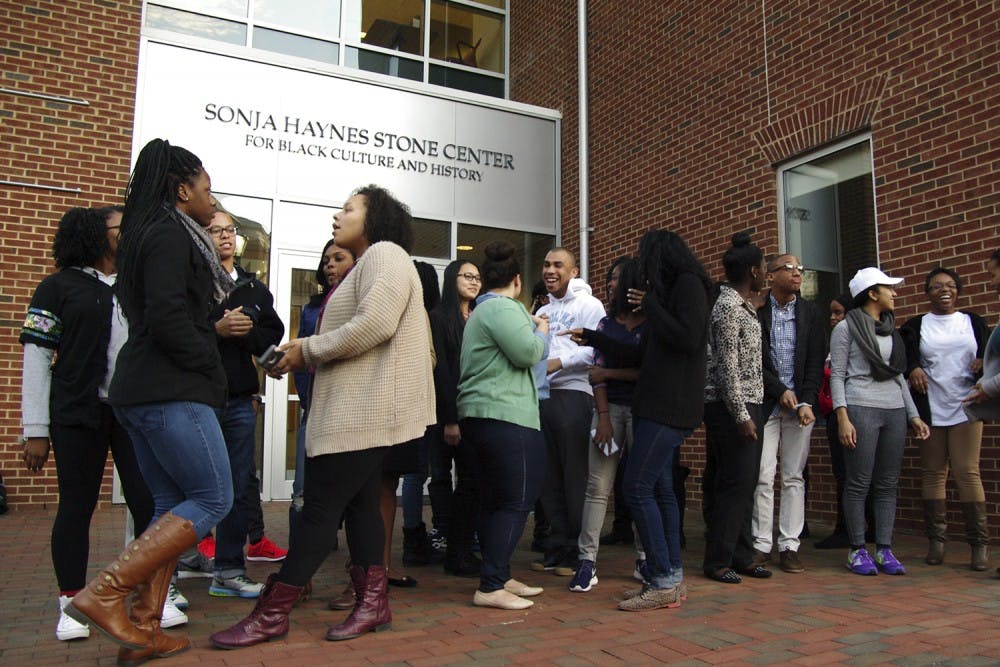Stone, the adviser to the group, died suddenly in 1991. Her death was unexpected, and her students immediately mobilized to honor her with a freestanding black cultural center in her name.
“She was integral in getting (the room). Upon her death, those of us who loved her, we wanted to name the center after her,” Thomas said.
The building would replace the Student Union as the site of the black cultural center, where students could discuss current events.
“To me, it was a lifeline,” Thomas said. “It was a place where I didn’t have to feel different and a place where I could truly let my hair down.”
Then-chancellor Paul Hardin was at times non-commital to the students’ cause.
“I favor a center that is, by geography and program, inviting and inclusive — a forum, not a fortress,” he said to protesters on the South Building lawn, according to a 1992 story in The Daily Tar Heel.
The issue was divisive, but groups like the Campus Y and student government eventually joined BSM in its advocacy.
The creation of a black cultural center was approved in 1992, but questions of where to locate the center remained.
In April 1993, activists had a choice — sit in Hardin’s office indefinitely or go to class. Sixteen students and a middle school teacher who chose the former option would be arrested after camping out in the chancellor’s office.
“These were all new experiences with me but it was a way to claim my identity as an African-American student,” said Chimi Boyd-Keyes, who was BSM president during the 1994-95 school year.
“Some students really just camped out there and ate, slept and did everything right there in South Building. It was very empowering.”
A spiritual leader came to anoint the grounds next to Wilson Library where the student advocates wanted the Center to be built, Boyd-Keyes said. After much back-and-forth, the center was ultimately built by the Bell Tower, across the street from the library.
To get the day's news and headlines in your inbox each morning, sign up for our email newsletters.
Even after some logistics of the center were agreed upon, Boyd-Keyes said there was a lot of miscommunication.
“People were saying there’d be a beauty shop and a barber shop, just a hang out spot for black students,” she said. “None of those thing were true, so I was also spending time as BSM president to educate about the purposes of the center.”
The Stone Center was originally proposed as a student-centered building, Boyd-Keyes said, but activists compromised and the center became more academic-oriented.
More than ten years went by before the Stone Center opened its doors. Administrators raised $9 million to build the center, but, at times, it didn’t seem like a huge priority, said David Eckerman, a retired UNC psychology professor.
“It took a lot of politics and negotiating to keep it on the agenda,” Eckerman said. “It’s a very complicated history, and it’s a history a lot of people in North Carolina would rather forget.”
After years of budget cuts for UNC’s centers, UNC’s Board of Governors is reviewing a short list of system centers and institutes, including the Stone Center. That review could end in the board pulling financial support.
At a Stone Center screening of “Don’t Believe The Hype,” a documentary chronicling the advocacy for the center, Ebony Watkins heard arguments for and against the center’s creation that were similar to debates about the center today.
“It literally felt like I was looking in the mirror,” said Watkins, who is also a member of the UNC BOG Democracy Coalition. “I really just felt like the same voices that were in favor of the center and the center being built and founded were the same exact (voices of today).”
Years-removed from the controversy, Hardin said he hopes the Stone Center is protected.
“The world, our great country, and especially the Board of Governors, all need to take a deep breath and stop playing fast and loose with doling out rights and privileges,” he said by email.
For Thomas, Stone’s mentee in the early 1990s, the Stone Center is exactly what she hoped it would be for the next generation of UNC students.
“For me, it is a gift to current and future students and to the entire campus community and to the region,” she said. “It is a place where rigorous academic inquiry and study and sharing happens — where new ideas and dreams and visions are born.”
special.projects@dailytarheel.com



